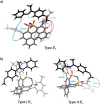Disulfonimides versus Phosphoric Acids in Brønsted Acid Catalysis: The Effect of Weak Hydrogen Bonds and Multiple Acceptors on Complex Structures and Reactivity
- PMID: 31550152
- PMCID: PMC6863592
- DOI: 10.1021/acs.joc.9b01811
Disulfonimides versus Phosphoric Acids in Brønsted Acid Catalysis: The Effect of Weak Hydrogen Bonds and Multiple Acceptors on Complex Structures and Reactivity
Abstract
In Brønsted acid catalysis, hydrogen bonds play a crucial role for reactivity and selectivity. However, the contribution of weak hydrogen bonds or multiple acceptors has been unclear so far since it is extremely difficult to collect experimental evidence for weak hydrogen bonds. Here, our hydrogen bond and structural access to Brønsted acid/imine complexes was used to analyze BINOL-derived chiral disulfonimide (DSI)/imine complexes. 1H and 15N chemical shifts as well as 1JNH coupling constants revealed for DSI/imine complexes ion pairs with very weak hydrogen bonds. The high acidity of the DSIs leads to a significant weakening of the hydrogen bond as structural anchor. In addition, the five hydrogen bond acceptors of DSI allow an enormous mobility of the imine in the binary DSI complexes. Theoretical calculations predict the hydrogen bonds to oxygen to be energetically less favored; however, their considerable population is corroborated experimentally by NOE and exchange data. Furthermore, an N-alkylimine, which shows excellent reactivity and selectivity in reactions with DSI, reveals an enlarged structural space in complexes with the chiral phosphoric acid TRIP as potential explanation of its reduced reactivity and selectivity. Thus, considering factors such as flexibility and possible hydrogen bond sites is essential for catalyst development in Brønsted acid catalysis.
Conflict of interest statement
The authors declare no competing financial interest.
Figures







Similar articles
-
Highly acidic N-triflylphosphoramides as chiral Brønsted acid catalysts: the effect of weak hydrogen bonds and multiple acceptors on complex structures and aggregation.Chem Sci. 2024 Apr 29;15(24):9104-9111. doi: 10.1039/d4sc01939c. eCollection 2024 Jun 19. Chem Sci. 2024. PMID: 38903236 Free PMC article.
-
Ternary complexes of chiral disulfonimides in transfer-hydrogenation of imines: the relevance of late intermediates in ion pair catalysis.Chem Sci. 2021 Nov 17;12(46):15263-15272. doi: 10.1039/d1sc03724b. eCollection 2021 Dec 1. Chem Sci. 2021. PMID: 34976346 Free PMC article.
-
Brønsted Acid Catalysis-Structural Preferences and Mobility in Imine/Phosphoric Acid Complexes.J Am Chem Soc. 2016 Dec 14;138(49):15965-15971. doi: 10.1021/jacs.6b09244. Epub 2016 Dec 5. J Am Chem Soc. 2016. PMID: 27960345 Free PMC article.
-
Chiral disulfonimides: a versatile template for asymmetric catalysis.Org Biomol Chem. 2020 Oct 7;18(38):7485-7513. doi: 10.1039/d0ob01742f. Org Biomol Chem. 2020. PMID: 32940322 Review.
-
Chiral Phosphoric Acids in Metal-Organic Frameworks with Enhanced Acidity and Tunable Catalytic Selectivity.Angew Chem Int Ed Engl. 2019 Oct 7;58(41):14748-14757. doi: 10.1002/anie.201908959. Epub 2019 Sep 5. Angew Chem Int Ed Engl. 2019. PMID: 31389142 Review.
Cited by
-
Chiral Phosphoric Acids as Versatile Tools for Organocatalytic Asymmetric Transfer Hydrogenations.European J Org Chem. 2021 Oct 14;2021(38):5367-5381. doi: 10.1002/ejoc.202100894. European J Org Chem. 2021. PMID: 34819797 Free PMC article. Review.
-
Highly acidic N-triflylphosphoramides as chiral Brønsted acid catalysts: the effect of weak hydrogen bonds and multiple acceptors on complex structures and aggregation.Chem Sci. 2024 Apr 29;15(24):9104-9111. doi: 10.1039/d4sc01939c. eCollection 2024 Jun 19. Chem Sci. 2024. PMID: 38903236 Free PMC article.
-
Ternary complexes of chiral disulfonimides in transfer-hydrogenation of imines: the relevance of late intermediates in ion pair catalysis.Chem Sci. 2021 Nov 17;12(46):15263-15272. doi: 10.1039/d1sc03724b. eCollection 2021 Dec 1. Chem Sci. 2021. PMID: 34976346 Free PMC article.
-
Dimerization of confined Brønsted acids in enantioselective organocatalytic reactions.Chem Sci. 2023 Sep 18;14(38):10580-10590. doi: 10.1039/d3sc03769j. eCollection 2023 Oct 4. Chem Sci. 2023. PMID: 37799993 Free PMC article.
-
Sulfonimide-Based Dendrimers: Progress in Synthesis, Characterization, and Potential Applications.Polymers (Basel). 2020 Dec 15;12(12):2987. doi: 10.3390/polym12122987. Polymers (Basel). 2020. PMID: 33333758 Free PMC article. Review.
References
-
- Parmar D.; Sugiono E.; Raja S.; Rueping M. Complete Field Guide to Asymmetric BINOL-Phosphate Derived Brønsted Acid and Metal Catalysis: History and Classification by Mode of Activation; Brønsted Acidity, Hydrogen Bonding, Ion Pairing, and Metal Phosphates. Chem. Rev. 2014, 114 (18), 9047–9153. 10.1021/cr5001496. - DOI - PubMed
-
- Terada M. Chiral Phosphoric Acids as Versatile Catalysts for Enantioselective Transformations. Synthesis 2010, 1929–1982. 10.1055/s-0029-1218801. - DOI
-
- Rothermel K.; Melikian M.; Hioe J.; Greindl J.; Gramüller J.; Zabka M.; Sorgenfrei N.; Hausler T.; Morana F.; Gschwind R. M. Internal Acidity Scale and Reactivity Evaluation of Chiral Phosphoric Acids with Different 3,3′- Substituents in Brønsted Acid Catalysis. Chem. Sci. 2019, 10.1039/C9SC02342A. - DOI - PMC - PubMed
LinkOut - more resources
Full Text Sources

